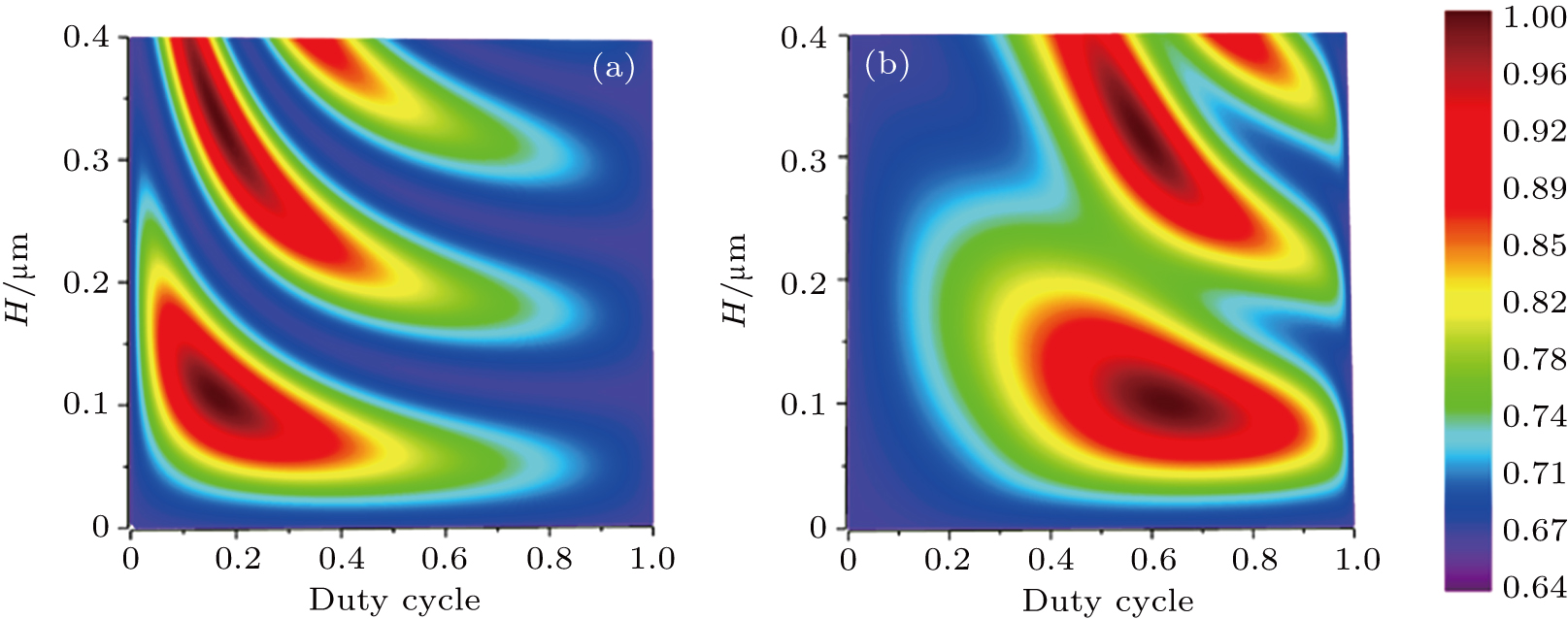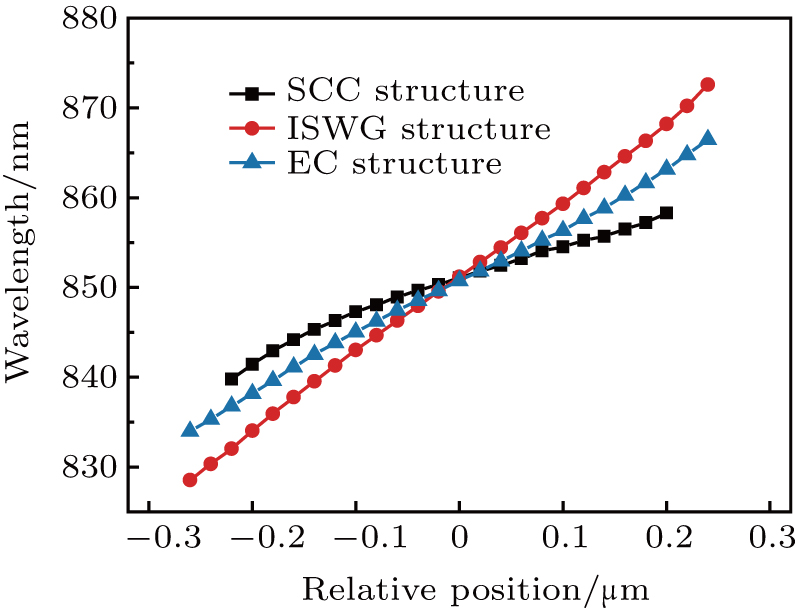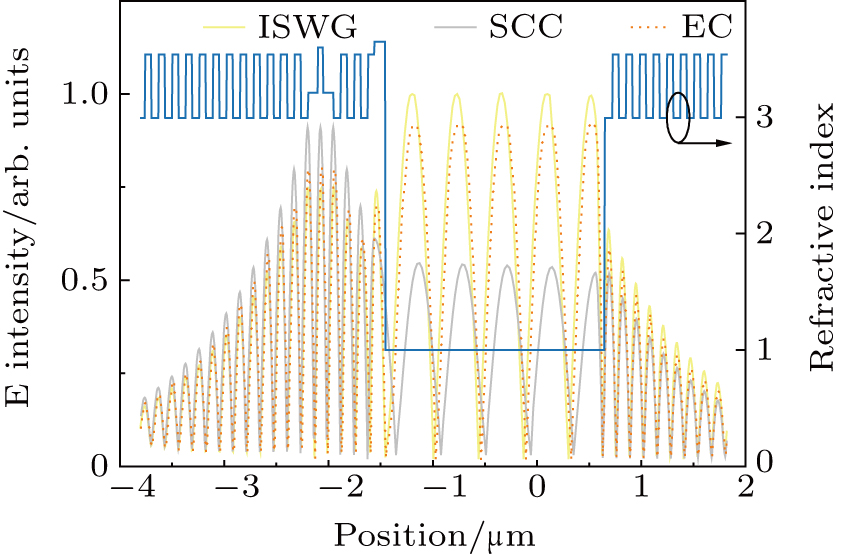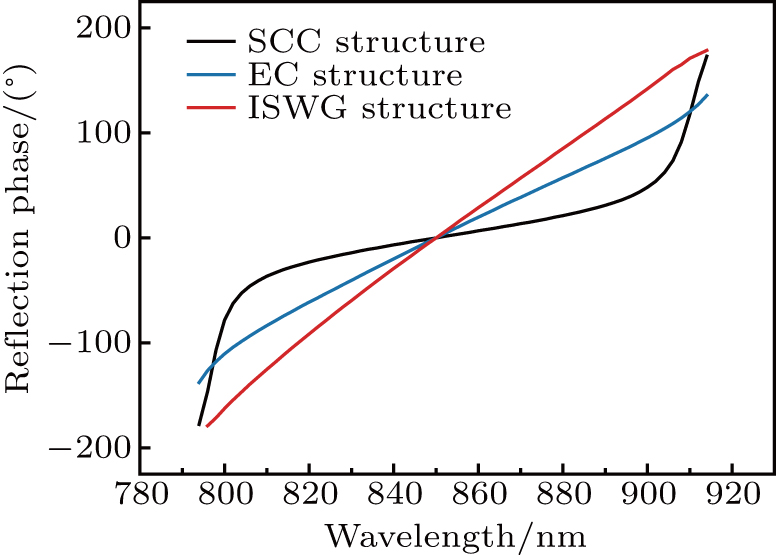† Corresponding author. E-mail:
Project supported by the Jilin Science and Technology Development Plan, China (Grant Nos. 20180519018JH and 20190302052GX), Jilin Education Department “135” Science and Technology, China (Grant No. JJKH20190543KJ), the National Natural Science Foundation of China (Grant No. 11474038), and the Key Project of Equipment Pre-Research Fund of China (Grant No. 61404140103).
We design an 850 nm tunable vertical-cavity surface-emitting laser (VCSEL) structure using an internal-cavity sub-wavelength grating. The use of such a tuning structure allows for wider wavelength tuning range and more stable single-polarization as compared to conventional tunable VCSELs. The features of the internal-cavity grating effect on the wavelength tuning and polarization characteristics of the tunable VCSEL are analyzed. The simulation results show that the largest wavelength tuning range achieves 44.2 nm, and the maximum orthogonal polarization suppression ratio (OPSR) is 33.4 dB (TE-type) and 38.7 dB (TM-type).
Tunable vertical-cavity surface-emitting lasers (VCSELs) have attracted great interest in many applications because of their low power consumption, single longitudinal mode, continuous wavelength tuning characteristics.[1] Especially, in optical communications, tunable VCSELs with polarization stabilization characteristics and wide wavelength tuning range could effectively improve the stability and rate of transmission information.[2,3] The output wavelength of a tunable VCSELs can be tuned by reducing the thickness of the air gap. However, the wavelength tuning range is hard to increase due to the high reflectivity between the semiconductor cavity and the air cavity. In addition, because of the cylindrical symmetry and isotropic material properties of the device, the polarization behavior of tunable VCSELs could not be fixed reliably.[4,5] When the temperature and injection current is changed, the polarization mode will randomly be switched between TE and TM. Therefore, tunable VCSELs with polarization stabilization and wide wavelength tuning ranges are a research hotspot. Bakker et al.[6] developed a VCSEL structure with asymmetric current injection; the polarization direction was controlled in the larger current injection. Frasunkiewicz et al.[7] and Belmonteet al.[8] developed a 1550 nm liquid-crystal tunable VCSEL, the output wavelength and polarization can be adjusted by tuning the voltage to control the deflection angle of the liquid crystal. This structure has the advantages of small tuning voltage and stable polarization. Kogel et al.[9] developed a 1550 nm tunable VCSEL with an asymmetric top DBR structure; the top DBR film has different bending angles in two orthogonal directions. Therefore, the anisotropies of TE and TM could be increased, with the wavelength tuning range 76 nm. Gründl et al.[10] developed a 1550 nm tunable VCSEL with a sub-wavelength grating (SWG). The SWG was written on the top-DBR mirror and facing the output surface of the VCSEL after two-chip mounting process, the polarization stable wavelength tuning was 25 nm. Chang-Hasnain et al.[11] developed a 1060 nm tunable VCSEL using a high-contrast grating (HCG) as the top mirror. The loss between the two polarization was increased using a high-contrast grating; the wavelength tuning range reached 76 nm. The 850 nm and 1550 nm tunable HCG-VCSELs have also been demonstrated in previous reports.[12–14]
Sub-wavelength structures have found numerous applications in different optical fields due to theirs special shapes and optical properties, such as polarization elements,[15] and diffraction gratings.[16] In addition, the new nanolithography technique for fabricating various subwavelength structures is also improved constantly.[17]
In this study, we design a tunable VCSEL structure at 850 nm with an internal-cavity sub-wavelength grating (ISWG) to achieve a wider wavelength tuning range and more stable single-polarization.
The rigorous coupled-wave theory is used to study the polarization characteristics of the sub-wavelength grating.[18,19] The sub-wavelength grating model is shown in Fig.
 | Fig. 1. Sub-wavelength grating structure. GaAs is the grating material, Λ is the period, H is the depth, a is the ridge width, and f = a/Λ is the duty cycle. |
The high-order diffracted light will exist in the grating when the ratio of the grating period to the wavelength exceeds the critical point. Figure
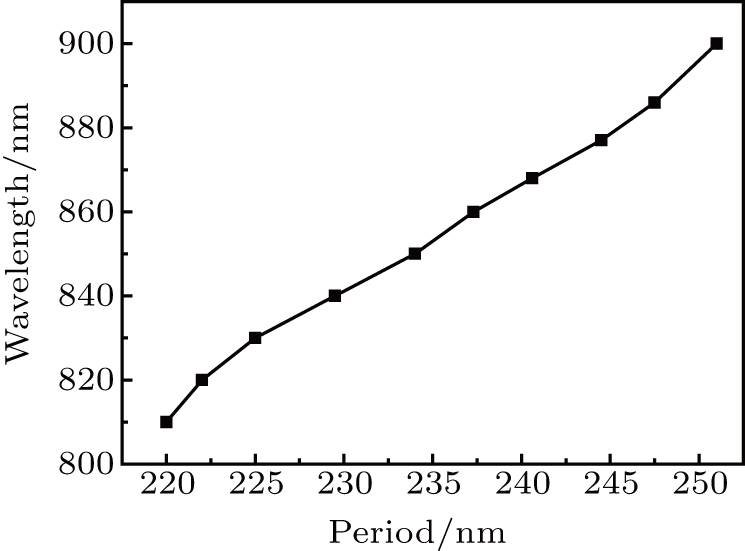 | Fig. 2. The relationship between the period of sub-wavelength grating and wavelength when only zero-order diffraction light exists. |
The transmittance of sub-wavelength grating with different parameters is calculated as shown in Fig.
The influence of grating shape on polarization characteristics should also be considered. A trapezoidal sub-wavelength grating model is built to analyze the effect of sidewall angles on the transmittance of two polarization, as shown in Fig.
 | Fig. 4. The schematic diagram of a trapezoidal sub-wavelength grating. Λ is the period, H is the ridge height, and θ is the inclination angle. |
The transmittance of sub-wavelength grating with different polarization types is calculated, as shown in Fig.
 | Fig. 5. The effect of θ on the transmittance and difference of polarization mode with the TE-type sub-wavelength grating (a) or the TM-type sub-wavelength grating (b). |
The tunable VCSEL structure with an internal-cavity sub-wavelength grating is shown in Fig.
We compared the wavelength tuning characteristics of the internal-cavity sub-wavelength grating (ISWG) structure with semiconductor coupled-cavity (SCC) structure and extended cavity (EC) structure. The schematic diagram of three tunable VCSEL structures are shown in Fig.
The wavelength tuning range of the three coupling types of the tunable VCSEL is calculated, as shown in Fig.
Figure
 | Fig. 10. The confinement factor (a) and the threshold gain (b) of the tunable VCSEL with SCC and ISWG structures, respectively. |
To illustrate the effect of sub-wavelength grating on wavelength tuning efficiency. According to Eq. (

To illustrate the polarization characteristics of the tunable VCSEL with the ISWG structure, we study the resonant wavelengths of two polarization modes for different air gaps. The influence of grating etching error (θ = 90°, 85°, and 80°) on wavelength separation is also analyzed; the results are shown in Fig.
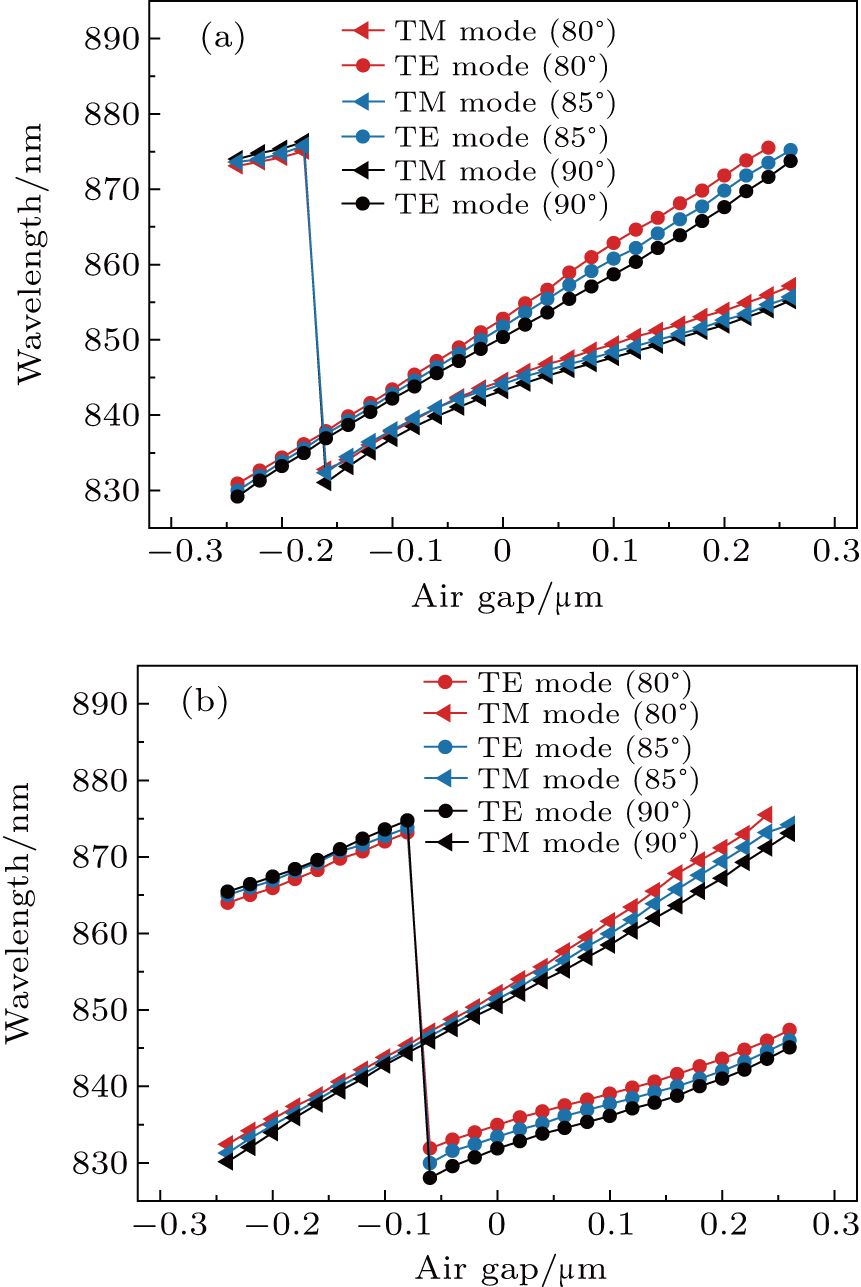 | Fig. 12. The wavelength tuning range of the two polarization modes for the TE-type (a) and TM-type (b) tunable VCSEL, respectively, when θ is different. |
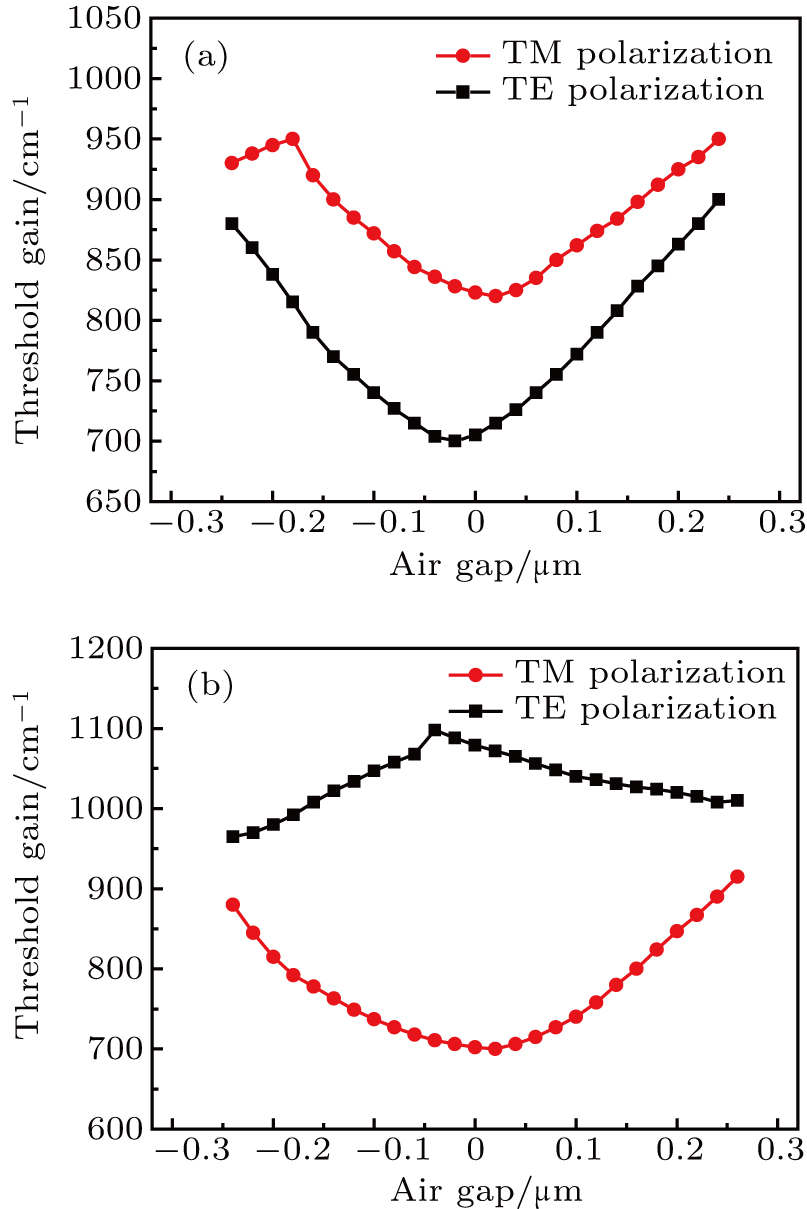 | Fig. 13. The relationship between threshold gain and different polarization modes for the TE-type tunable VCSEL (a) and the TM-type tunable VCSEL (b). |
For TE-type tunable VCSEL structures, the maximum wavelength separation of the two polarization modes is 17.5 nm; the wavelength separation is always higher than 4 nm. For the TM-type tunable VCSEL structures, the maximum wavelength separation of the two polarization modes is 28 nm, the wavelength separation is still higher than 17.6 nm. At the same time, we observe that there are little dependences of the polarization characteristics and wavelength tuning range of tunable VCSEL on the grating shape. With θ in 80°–90°, the TE and TM polarization always maintain a significant value of wavelength separation. For the TE-type tunable VCSEL structures, the TM polarization can be suppressed effectively because of the threshold gain of TE is always smaller than TM. The switching phenomenon between TE and TM polarizations is avoided. Compared with the TE-type tunable VCSEL structure, the TM-type tunable VCSEL structure has a more significant threshold gain difference, especially near the central wavelength. Therefore, the TM-type tunable VCSEL structure has a stronger suppression ability for the TE polarization. In the case of low current injection, the results show that the tunable VCSEL structures with different types of sub-wavelength gratings can effectively avoid the polarization switching during wavelength tuning.
For the central wavelength of 850 nm, the orthogonal polarization suppression ratio (OPSR) with different injection currents is calculated by

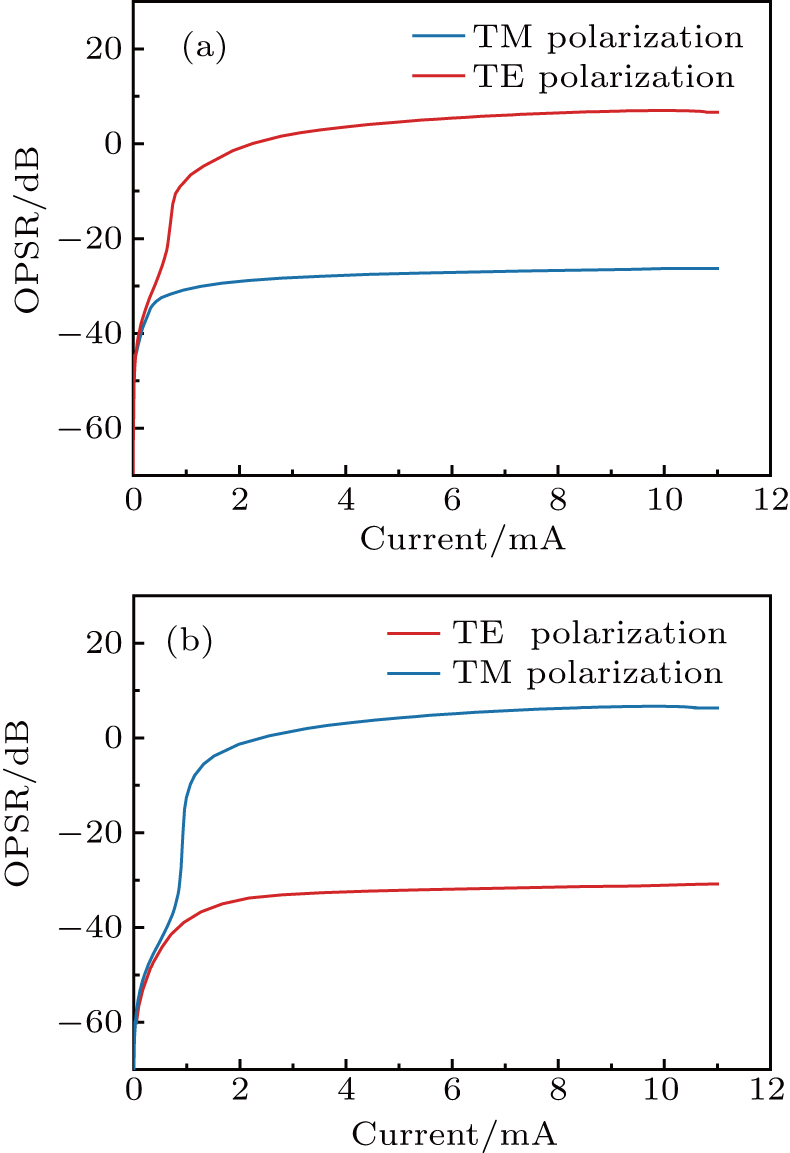 | Fig. 14. At different injection currents, the OPSRs of the TE-type tunable VCSEL (a) and the TM-type tunable VCSEL (b). |
The resonance wavelength, which is close to the material gain peak, can obtain high quantum well gain and play a dominant role in the mode competition. The degree of suppression between modes is proportional to the difference in relative gain. Combined with the material gain spectrum and wavelength separation state, the polarization mode characteristic with high current injection during the wavelength tuning is analyzed. Figure
For the TE-type tunable VCSEL structures, the resonant wavelength of the TM polarization mode is switched from 832.3 nm to 875.8 nm. However, the TM polarization mode still has a lower quantum well gain compared to the TE polarization mode. Therefore, the tunable VCSEL can maintain stable TE polarization during the wavelength tuning. Because the TM-type tunable VCSEL structure has a more significant value of wavelength separation, it has a higher polarization suppression ability. However, when the tuning wavelength of the TM polarization mode is 840 nm, the gains for the TM and TE polarization modes are close to each other, the competition between polarization modes increases, the polarization suppression ability of the device decreases. When the TM tuning wavelength is less than 840 nm, the TE polarization mode plays a dominant role in mode competition and the mode hopping will incur in the device. The results show that the TE-type tunable VCSEL structure has stable single-polarization output characteristics in the process of continuous wavelength tuning. The TM-type tunable VCSEL structure has the most stable output characteristics of a single polarization mode near the low current injection. However, at the high current injection, the wavelength tuning range of stable polarization mode is smaller than the TE-type tunable VCSEL structure.
We have designed an 850 nm tunable VCSEL structure with internal-cavity sub-wavelength grating (ISWG). The effects of sub-wavelength grating’s parameters (period, duty cycle, ridge height) on the transmittance and effective index of the two polarization modes (TE/TM) are analyzed. The results show that the subwavelength grating has good polarization characteristics and large tolerance, so the difficulty of fabrication can be reduced to some extent. We theoretically study the optical characteristics of tunable VCSEL structures with three different coupling types and it is demonstrated that the ISWG structure is significantly effective for increasing the wavelength tuning range. In addition, we calculate the polarization power and threshold gain characteristics of such an ISWG VCSEL and show the possibility of achieving a single-polarization mode within the wavelength tuning range. In the fabrication process, the thickness variation of the bonding material before and after curing needs to be considered, which will affect the output wavelength and free spectral range of the device. The results show the largest wavelength tuning range achieves 44.2 nm. The maximum orthogonal polarization suppression ratio (OPSR) is 33.4 dB (TE-type) and 38.7 dB (TM-type), respectively. It is shown that the tunable VCSEL with ISWG could achieve stable polarization, and eliminate the defect of polarization mode instability.
| [1] | |
| [2] | |
| [3] | |
| [4] | |
| [5] | |
| [6] | |
| [7] | |
| [8] | |
| [9] | |
| [10] | |
| [11] | |
| [12] | |
| [13] | |
| [14] | |
| [15] | |
| [16] | |
| [17] | |
| [18] | |
| [19] |


